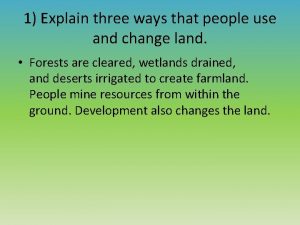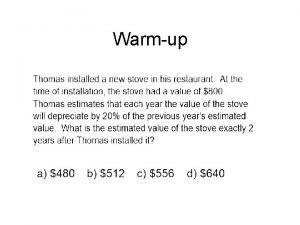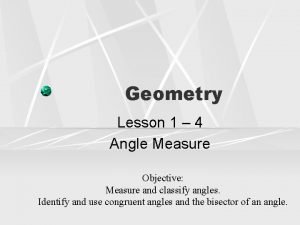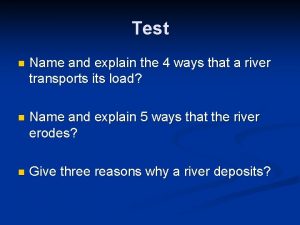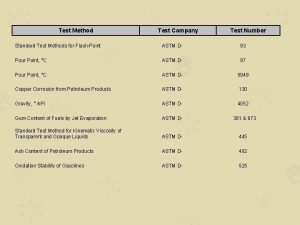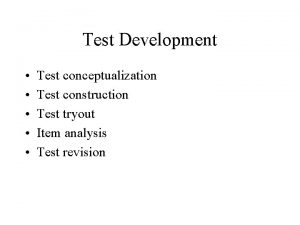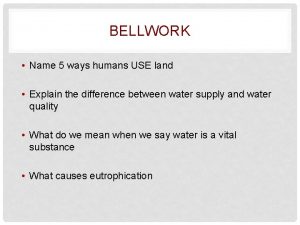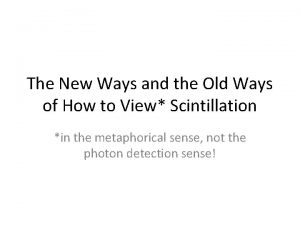Test n Name and explain the 4 ways



























- Slides: 27

Test n Name and explain the 4 ways that a river transports its load? n Name and explain 5 ways that the river erodes? n Give three reasons why a river deposits?

Features source drainage basin – watershed – tributary -. confluence – mouth Definition

Features Definition source - point at which a river starts. drainage basin – the total area of land drained by a river and its tributaries. watershed – the area, normally a ridge of high ground that separates one drainage basin from another. tributary -. a small river / stream which joins the main river confluence – the point at which a tributary joins the main river. mouth the point at which a river enters a lake or the sea.

Drainage Patterns Dendritic: Tree like branch pattern where tributaries converge into a main river. Develops on gently sloping land of uniform rock type. E. g. Shannon Radial: Streams move out from a central high point - a hill or mt. Wicklow mts. Trellised: Tributaries join at right angles. Occurs where land has been folded or varied rock bands. E. g. . Lee Deranged: Random and chaotic pattern. Found in marshy lowlands & clay soils. E. g. . Cavan area.

Drainage Patterns


River Discharge: Volume of water passing a certain point at a given time in a river channel. Greater the discharge = great capacity to erode & transport. Discharge greater in winter. Shown on a hydrograph…. Shows suitability for HEP, water supply & irrigation. Also used to predict flood risk & flood control measures. River Velocity: (speed) Effected by 1. Gradient… steeper = faster 2. Discharge… larger = more energy 3. Channel shape… more contact with bed & banks (wetted perimeter) - more friction - reduce energy & speed - 95% of energy used for moving 4. Channel roughness… uneven bed & banks, potholes & boulders - friction & turbulent water - reduce energy & speed River Flow: Mainly turbulent flow, this increases with velocity-- movement in all directions – necessary for transportation and erosion


Processes of Erosion Hydraulic action: The force of the water…. . Stronger current = greater erosion. turbulent and eddying water can undermine banks causing bank caving. Cavitation (air bubbles collapsing forming tiny shock waves also loosen soil. Solution: Chemical erosion of rocks, dissolving minerals which are carried in solution, particularly in areas of chalk or limestone Abrasion: River armed with material (pebbles, sand, gravel) which it uses to erode. Uses it load to erode. Greatest erosive power when in flood. Pebbles whirled by eddies form potholes. Attrition: River load is worn down as it hits off itself, pebbles are rounded and smooth Vertical erosion: Downward erosion of the bed Lateral erosion: Side wards, erodes the bands Headward erosion: River erodes in the opposite direction to which it flows.

Processes of Transportation Solution: The dissolved load. Suspension: Visible cloud of sediment (brown colour) -- clay & silt carried within the flow. Saltation: Smaller particles are bounced along the river bed subject to the force of the water. Traction: Heavy load is rolled along the river bed. Deposition Material sorted by deposition… heaviest dropped first then lightest (clay & silt) last = alluvium. Depends occurs when: 1. Velocity… reduced as it enters sea or lesser gradient. 2. Discharge…. Less water due to less precipitation 3. Increased load…. Increased soil erosion after a flood or if new tributary joins

River profile: slope from source to base. Always trying to reach its perfect graded profile but it never happens due to differences in rock type, presence of lakes etc. 1 • 2 3 Small stream… vertical erosion…. deep valley 2. Tributaries join… lateral erosion…wider valley 3. Full size river… deposition…. valley filled in

n Youthful stage: Dominant process is erosion n Features: V shaped valley: Narrow, steep sided and deep valley…. Due to vertical erosion. River is weak but fast flowing & volume is small. Hydraulic action attacks the bed, cutting downwards. Corrosion cause rocks to break down & increases vertical erosion --- steep slopes & narrow floor develop as v shape. River follows a zig-zag course as it finds the path of least resistance which leads to interlocking spurs Weathering and mass movement also aid in the formation of the V-shaped valley E. g. . Barrow, Co Laois. n n


Waterfall: A layer of resistant rock lies beside or across soft rock. Soft rock erodes faster -- differential erosion - a fall develops as the river bed is steepened. Water drops on the underlying soft rock and wears it away. Water backlashes and mist rots rock to form a cave. The overhang collapses since the rock is undercut. This collapsed rock swirls & carves out a plunge pool. Hydraulic action: Speed is increased as it approached the fall - increase hydraulic action Attrition: Eroded the soft rock and deepened the plunge pool. It dissolves, weakens & breaks up rocks. Abrasion: Eroded material used to gouge out a plunge pool. Waterfall retreats upstream -- headward erosion creating a gorge Niagra falls has created a 12 km gorge, retreating upstream by 1 m a year. Has been reduced as some water now diverted for HEP E. g. Powerscourt Co Wicklow. Dargle. Torc, Killarney Co Kerry. Flesk


Mature stage Meander & ox-bow lake Meanders are curves or bends in a river. Formed by erosion & deposition. Water flows faster on the concave (outside) & slower on the convex (inside). The outside bend increases in size due to hydraulic action & abrasion. This lateral erosion increases the curve size. Secondary flows (corkscrew in shape) move material from the convex & deposit it on the concave. This deposition of sand & shingle forms a point bar. The meander becomes pronounced & a neck develops. During a flood the rivers cuts through he neck & forms a new course. In time the river deposits along its banks & cuts off the bend forming an ox-bow lake and eventually a meander scar. E. g. . Nore Co Kilkenny, Suck, Co Galway.


Flood Plain A flat low-lying area flooded by a river. Processes: Corrasion, attrition, solution. Lateral erosion predominates. River floods, overflows its banks & deposits silt. Coarser material deposited close to banks & alluvium (finer) deposited on outer flood plain. Edge of flood plain marked by a bluff line (slope). Material accumulates over time. Forms levees on river banks. Drained flood plains are very fertile…. good agric. land. E. g. . Shannon, south of Athlone.

Lower Course Delta: A flat area of alluvium deposited by a river when it enters a lake or the sea. Velocity of river decreases and it deposits load. Flocculation is where sediments clot on contact with sea water. Heavier material is laid down first & the lighter material carried further. The tides are unable to remove the sediments and the river channel becomes choked. Bottomset Beds are layers of fine sediment carried out furthest Foreset Beds are thicker coarser layers that are laid closer to the river Topset beds are a mixture of material deposited nearest to the land These form islands or braids. This causes the mouth of the river to divide into channels called distributaries.

n n Estuarine Delta: Forms at mouth of river as material is deposited along the banks of the river. An island may form in the centre of the river. E. g. . Rhine Delta or Shannon Lacustrine Delta: Formed as a river flows into a lake. Alternate layers of fine (summer deposits) and coarse material (winter deposits). EG Lough Tay co Wicklow. Arcuate Delta: triangular Shape, sea currents strong keep the outer edge straight e. g. Nile Delta Bird’s Foot Delta: Relatively small number of distributaries extend into sea like a birds foot e. g. Mississippi Delta



Change in base level: River rejuvenation 1. Land level rises relative to the sea (isostatic) Uplift after a glacial period ends. 2. Sea level falls relative to the land. ( eustatic) Onset of ice age 3. Tectonic movement causes folding and uplifting. 4. River gets new energy as its gradient increases & the land emerges from the sea due to any of the above. It has an increased ability to erode. rejuvenation

Knickpoint: The intersection between the old and new profile. Often marked by a waterfall or weir. Due to headward erosion. EG Barrow, Bagenalstown Co Carlow. Paired Terraces: Vertical erosion abrasion & hydraulic action erodes the clay silt and bedrock and forms a new narrower floodplain at a lower level. Lateral erosion creates a pair of terraces as margins of the floodplain. A series of these occurs with rejuvenation & are left high above the new floodplain. EG Dodder, Terenure, Dublin Incised meander: If downcutting is severe the river cuts a deep meander into the valley floor. EG Nore, Thomastown Co Kilkenny,


Drainage pattern of south of Ireland A chalk surface was uplifted & faced south. Consequent streams…. Follow direction of slope, flowed south Eroded and exposed sandstone anticlines. Rivers cut into landscape and superimposed themselves. Subsequent streams… tributaries flowed at right angles to the consequents. Developed as they flowed on the chalk. These streams, by headward erosion, cut through to new catchment areas. They intercepted the consequent & changed its direction of flow. This is called river capture. C 2 C 1 S 2 Wind gap

A beheaded stream remains & the bend where the river was captured is called the elbow of capture. Below this a wind gap marks the now dry former course of the beheaded stream. The beheaded stream is a misfit stream as it is very small in relation to the valley through which it flows. The chalk was eroded & tributaries flowed down the anticline, joining at right angles. This gives us a trellised pattern of drainage along the Suir & Blackwater rivers.
 Gods ways are not our ways
Gods ways are not our ways Explain three ways of
Explain three ways of Name 3 points
Name 3 points Postulate 1-4
Postulate 1-4 Name
Name Name two ways to prevent conflicts from building
Name two ways to prevent conflicts from building How to name an angle in 4 ways
How to name an angle in 4 ways How to name an angle in four ways
How to name an angle in four ways Pivoting section hair
Pivoting section hair Main part of a seed
Main part of a seed Hình ảnh bộ gõ cơ thể búng tay
Hình ảnh bộ gõ cơ thể búng tay Slidetodoc
Slidetodoc Bổ thể
Bổ thể Tỉ lệ cơ thể trẻ em
Tỉ lệ cơ thể trẻ em Chó sói
Chó sói Thang điểm glasgow
Thang điểm glasgow Chúa yêu trần thế alleluia
Chúa yêu trần thế alleluia Kể tên các môn thể thao
Kể tên các môn thể thao Thế nào là hệ số cao nhất
Thế nào là hệ số cao nhất Các châu lục và đại dương trên thế giới
Các châu lục và đại dương trên thế giới Công của trọng lực
Công của trọng lực Trời xanh đây là của chúng ta thể thơ
Trời xanh đây là của chúng ta thể thơ Mật thư tọa độ 5x5
Mật thư tọa độ 5x5 Làm thế nào để 102-1=99
Làm thế nào để 102-1=99 Phản ứng thế ankan
Phản ứng thế ankan Các châu lục và đại dương trên thế giới
Các châu lục và đại dương trên thế giới Thơ thất ngôn tứ tuyệt đường luật
Thơ thất ngôn tứ tuyệt đường luật Quá trình desamine hóa có thể tạo ra
Quá trình desamine hóa có thể tạo ra

